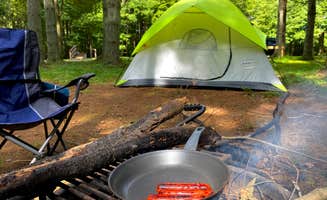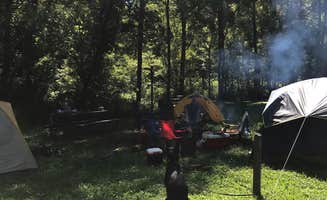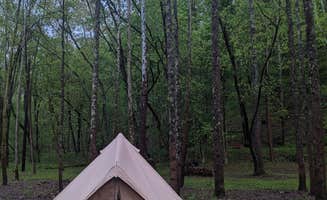Tent camping near St. Marys, West Virginia offers primitive sites within the Wayne National Forest across the Ohio River. Located in the Mid-Ohio Valley region with elevations between 600-900 feet, most sites experience high humidity in summer months with temperatures regularly reaching 85-95°F. Primitive campgrounds typically close during winter hunting season from late November through early April, though some remain accessible year-round with limited maintenance.
What to do
Trail exploration on foot: Baileys Trail Tent Camping offers excellent access to wooded hiking paths. One camper noted, "Nice wide open space surrounded by woods. There were other campers but very friendly and had plenty of space to ourselves."
Historic structure photography: Many camping areas feature historic structures ideal for photographers. According to a visitor at Hune Bridge Campground, "There is a covered bridge, but it's closed and full of local yocal graffiti," making for interesting visual documentation despite its condition.
Autumn camping: The region offers excellent fall foliage viewing from mid-October through early November. During this period, nighttime temperatures drop to 40-50°F while daytime remains comfortable for outdoor activities. Water levels in creeks are typically lower, requiring filtration systems rather than relying on natural sources.
What campers like
Affordability: The free camping options throughout Wayne National Forest are popular with budget-conscious travelers. One visitor to Lane Farm Campground shared, "It is completely FREE, though, and you can stay for up to 14 days. There are quite a few small campgrounds in the area just like this one."
Basic amenities: Most sites provide essential facilities without overcrowding. A camper at Lamping Homestead Recreation Area commented, "Each site had a picnic table and campfire ring, but there is no privacy between sites. There is no water available, other than the pond, so plan accordingly."
Wildlife viewing: Early morning hours provide opportunities to spot deer, turkeys and smaller forest mammals. Sites near water features attract various bird species throughout spring migration periods. Camping areas with ponds often feature amphibian activity after dusk during warmer months.
What you should know
Limited facilities: Prepare for primitive conditions at most sites. A reviewer at Conaway Run State Lake explained, "Pretty rustic. Porta potties are all that is available. No running water so you have to bring your own."
Cell service considerations: Communication capabilities vary significantly between campsites. At Lane Farm Campground, "There is no phone service within 4-5 miles of the campground," requiring advance planning for emergency contacts or navigation.
Site availability patterns: Most primitive sites in Wayne National Forest fill quickly on summer weekends but remain available midweek. Spring and fall offer better availability with cooler temperatures. Holiday weekends typically reach capacity by Thursday evening at no-reservation locations.
Road conditions: Access roads to several campgrounds are unpaved and may become difficult after heavy rainfall. Low-clearance vehicles can access most sites during dry conditions, but rutted roads may present challenges during wet periods.
Tips for camping with families
Best beginner option: Kinderhook Trailhead offers a balance between accessibility and primitive camping. A visitor observed, "I'd assume you'd also be allowed to create your own site, if the two designated sites are taken. There's not a ton of room, but I'd say another 5 sites could setup and be somewhat spread out."
Safety planning: Families should prepare for limited emergency services, with nearest hospitals 20-30 minutes away in Marietta, Ohio or Parkersburg, West Virginia. Parents should carry basic first aid supplies and familiarize themselves with the quickest routes to medical facilities.
Activity scheduling: During summer, schedule hikes and water activities before 11am or after 4pm to avoid peak heat. Morning wildlife observation opportunities are particularly good at pond-adjacent sites between 6-8am when animals visit water sources.
Supply recommendations: Pack additional water containers as no potable water exists at most sites. A minimum of one gallon per person per day is recommended during summer months when high humidity increases dehydration risk.
Tips from RVers
Size limitations: Only smaller rigs can access most campgrounds in this region. A camper at Lane Farm Campground shared, "It's designed for tent camping, but Hamlet (our small camper) fit fine with some strategic parking."
Generator restrictions: Most primitive sites prohibit generators or have strict usage hours. RVers relying on electric equipment should bring alternative power sources like solar chargers or battery banks to maintain devices.
Leveling challenges: Bring extra leveling blocks as many sites feature uneven terrain. The clay soil common throughout the region can shift during rainfall, potentially affecting previously level setups during longer stays.




